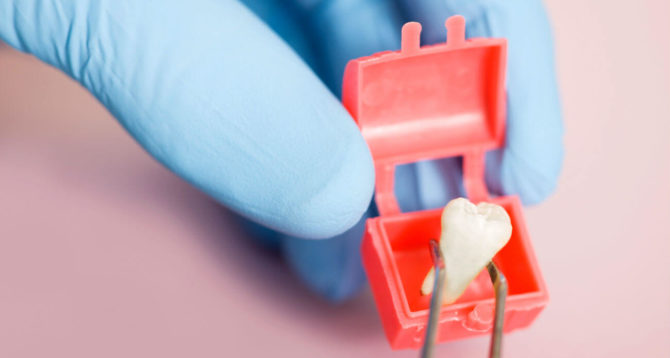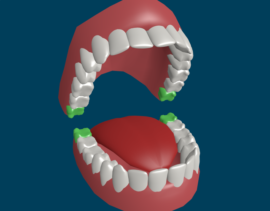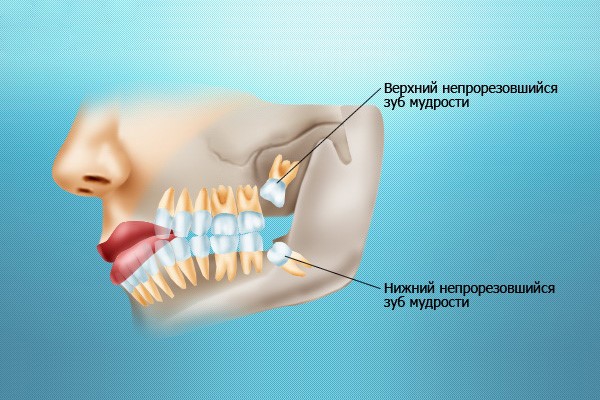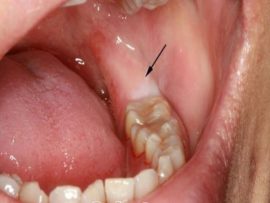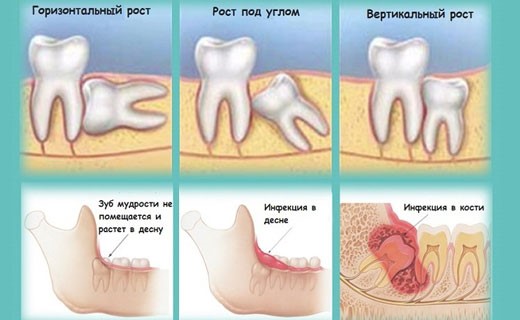Tooth of Wisdom: Signs and Symptoms of Growth
The wisdom teeth are the last to take part in the formation of the jaw of a person. By the time they appear, the entire main dentition has already been formed. When wisdom teeth grow, characteristic symptoms arise, their appearance is accompanied by unpleasant and painful sensations, sometimes complications. And yet, for some reason, nature created them.
Content
What is known about wisdom teeth and why are they needed
The teeth of wisdom owe their noble name to the time of their appearance. They are cut last, already at a conscious age, namely: at the age of 17–25. “Wise” teeth do not make a person smarter or more experienced, just at that time he enters the period of growing up, and life experience acquired by this moment makes him smarter and more reasonable. But this is not the only name for the teeth.
In dentistry, they are called eights or third molars. In the development of third molars, a pattern is observed: in women, the wisdom tooth often grows above, in men, on the contrary, from below. Their total number is 4 pieces. An adult representative of the australoid race may develop an additional molar - the fourth. But such a phenomenon is extremely rare.
Modern science reckons wisdom teeth among the so-called vestiges - organs that have lost their necessity in the course of evolutionary development. It was in ancient times that people ate hard foods, which had to be chewed for a long time. Modern man no longer feels an urgent need for eights, wonderfully managing with chopping food and 28 teeth. But they can serve an invaluable service in bridge prosthetics, and in the absence of a “neighbor” for some reason, they can take on a chewing function.
It is not difficult to understand that wisdom teeth appear, since the symptoms of this process are very pronounced. The molar is cut painfully, is not always formed correctly, but this trend is not logical. Its appearance can occur sensitively, but without burdening with consequences.
When and how do wisdom teeth grow
At the age of three, when the milk teeth in children are actively cut, the formation of wisdom teeth begins, and their number is determined. A lot of time is spent on development. In an adult, third molars begin to climb out by the age of 17but sometimes the process is stretched. Up to 25 years, the growth procedure in most people ends.
On the lower and upper jaw, on the right and left side, one eight should grow. But sometimes it happens that wisdom teeth are cut out not 4, but 3, 2, 1 or 0. The number of eights and how many years the first wisdom tooth grows depends on the hereditary factor, the anatomical shape of the jaw, its developmental features.
The moment when the molar is cut may last several days, and may stretch for a longer period. The process of its growth from an embryo to a full tooth occurs in several stages:
- The formation of a molar in the gum. It lasts from 3 to 16 years.
- The development of a tooth occurs up to 25 years and in the following order: crown, neck, root.
- Signs of teething eight appear: gum swelling, itching, pain.
- On the surface of the gums the tip of the wisdom tooth is shown, and after some time, a whole molar.
The first wisdom tooth appears approximately at the age of 17. In especially rare cases, teeth grow up to 40 years. There are no exact age limits for its pecking; this indicator is individual in each case.
Wisdom Teething Symptoms
After the number of teeth reaches 28, signs of the growth of a wisdom tooth may suddenly appear. They crawl out slowly, in some almost imperceptibly, in others accompanied by complex symptoms.
However, without problems, they grow extremely rarely. This is because molars form for a long time and at the moment when they begin to erupt, the jaw is already formed. Whatever side the 3 molars appear on, they simply might not have enough space.
Signs of teething wisdom are as follows:
-
The gums become painful. The condition is due to the pressure of the figure eight on the mucosa, trauma to the gums, compression of the bone tissue. A person hurts the place where the molar climbs. Usually no medical intervention is required.
- Constant aching pain appears. She can talk about the onset of inflammation in the gums. A visit to the dentist is required, as sometimes the wisdom tooth does not grow correctly due to dystopia - the molar’s position is incorrect — and only a specialist can determine this.
- The gum and cheek swell. Where a molar erupts, a hood of gum tissue may appear. Pus is released from it, an unpleasant odor from the mouth appears. The condition is dangerous by the development of pericoronaritis, which again, only a dentist can reliably determine.
- Temperature increase. It is a sign of the inflammatory process that occurs in the body of women and men.
- Difficulty opening the mouth. It talks about the spread of the inflammatory process to the masticatory muscles.
- When swallowing, the throat begins to hurt. A sign indicates the development of an abscess abscess.
- Enlarged lymph nodes. It is associated with an aggravation of the inflammatory process.
- The pain extends to the area of the ear, neck, temple. Means that inflammation has affected nerve endings.
Wisdom tooth growth during pregnancy
The expectation of a child is accompanied by a surge of hormones, which can be an impetus for the growth of a wisdom tooth. And although it is not recommended for pregnant women to treat diseases of the oral cavity, the period when the wisdom tooth is cut can be complicated, and the provision of medical care will become vital.
The start of dental procedures should occur at 16 weeks, and their end - at 32, that is, the period from 4 to 8 months is not dangerous for the treatment of teeth of a pregnant woman.
What to do to reduce pain
It is not difficult to understand that a wisdom tooth is growing, because the process is accompanied by a number of symptoms, even if they are expressed implicitly. It’s harder to alleviate the condition.
If the gum in the place of growth of the wisdom tooth inflamed and hurts, it is appropriate to use traditional and traditional medicine. The first impulse in the event of pain is to drink an anesthetic. It is natural, but should not become a panacea, since drowning out pain, you can miss the moment of the development of "just malaise" into a real threat to health. That is why a visit to the doctor in most situations is required.
After making sure that there are no complications, wisdom teeth come out without problems, but with pain symptoms, you can alleviate the condition with the help of folk remedies:
- Sage, lemon balm, oak bark, chicory root, chamomile individually or in collections 1: 1 do an excellent job with gum disease. Decoctions or infusions are prepared from plants and rinsed with an oral cavity a certain number of times a day: from 4 to 6.
- Soda-saline solution. In a glass of warm boiled water, take 1 tablespoon of soda and salt, and a drop of iodine is added to increase the effect. The tool anesthetizes the gums in the place of growth of the wisdom tooth, relieves swelling and inflammation.
- If wisdom teeth erupt too painfully, special pharmacy painkillers and freezing gels will help. Like those purchased for children with teething.
You can find out what can never be done when the figure eight climbs out, from the following list:
- warm the place of growth of the molar;
- rinse your mouth with hot solutions;
- make compresses.
Possible growth complications
There is a pattern: if wisdom teeth appear in adulthood, the process is more complicated. To understand why this happens, it is enough to imagine that the neighboring teeth are not just long formed, but have steadily taken their place in the human oral cavity.
Of great importance is how exactly the wisdom tooth climbs, since the pathological directions of its growth are often found:
- medial - an inclination towards the seven;
- distal - tilt back;
- buccal - towards the cheek;
- horizontal or linguistic - to the roots of adjacent teeth.
The consequences associated with improper growth of the molar:
- trauma to the cheek, ulcerative lesions of the mucosa;
- shifting the dentition and changing the bite;
- curvature of adjacent teeth and their destruction.
These deviations in the growth of extreme molars become the cause of the inflammatory process. Prolonged cutting of the figure eight is also undesirable. The process, which dragged on for several years, will inevitably lead to injury to the gums and its deformation, which will end in inflammation.
If the wisdom tooth grows with pathology, the patient may experience the following diseases:
- Pericoronaritis. Appears when the teething is incorrect or incomplete. May go into chronic form.
- Caries. The inconvenient location of the last molar leads to the development of caries, which is accompanied by blackening of enamel, increased sensitivity, the occurrence of pain. Sometimes eights become infected with caries before they appear and erupt already sick.
- Periodontitis The gap between the gum and the crown begins to become inflamed. The process is accompanied by pain, swelling, inflammation. The extreme manifestation is flux.
- Cyst. A benign neoplasm appears due to the long growth of the molar or the presence of inflammation in the gum.
Symptoms of wisdom tooth growth can be aggravated by inflammation of the trigeminal nerve, the development of especially patient patients with abscess, phlegmon, and other dangerous diseases. Therefore, sometimes dentists decide whether to remove a wisdom tooth.
If you have to remove a wisdom tooth
Extraction of the Eight is an extreme measure. Dental surgeons decide on a similar operation, if there is no other way. The complexity of the development of molar roots only exacerbates the situation: they can be from 1 to 5, since they take longer to form.
After the operation, ensure a good rest and follow the doctor’s instructions exactly. Check if the blood clot formed in the hole after removal has dropped out, since its presence ensures proper healing of the gums.
Do not rush to brush your teeth in the first 24 hours after the procedure and do not rinse your mouth in the first 48 hours with any decoctions and infusions. Analgesic drugs can help with pain, and in special cases, the doctor may prescribe anti-inflammatory drugs or prescribe antibiotic therapy.
Remember that the removal of a wisdom tooth is a necessary measure, and in this matter the opinion of the dentist can be the only right one. There are times when the gum cutting procedure is enough. The operation is performed under anesthesia, so the patient is not hurt, and the wisdom teeth after it grow without painful symptoms.

